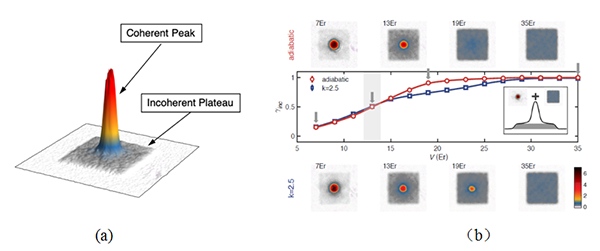Supported by the National Natural Science Foundation of China (Grant No.: 91736208), the team of Professor Xuzong Chen and Professor Xiaoji Zhou, School of EECS, Peking University, and the team of Professor Jiazhong Hu and Professor Wenlan Chen, Department of Physics, Tsinghua University, investigated the dynamic behavior of multi-body quantum phase transition from superfluid to Mott insulator by using a new optical lattice band mapping method. Different values of the same quantum critical parameters are observed, which is beyond the description of phase transition dynamics (Kibble-Zurek mechanism). This research achievement was published in Physical Review Letters (Phys. Rev. Lett. 127, 200601, 2021) under the title of "Observation of Many Body Quantum Phase Transitions beyond the Kibble-Zurek Mechanism". The paper’s link is: http://journals.aps.org/prl/abstract/10.1103/PhysRevLett.127.200601.
Nonequilibrium physics and dynamic behavior is an important and challenging direction in modern physics. For the dynamic behavior of phase transition, people qualitatively discuss it based on the nature of spontaneous breaking of symmetry, so as to obtain the universal scale law on the dynamic behavior of phase transition, namely Kibble-Zurek mechanism. This dynamic description method of phase transition has been widely used in many systems. However, with the extension of the phase transition mechanism, from the traditional thermodynamic phase transition to the quantum phase transition, from the spontaneous breaking of symmetry to the topological phase transition without symmetry description, can the Kibble-Zurek mechanism describe these broader phase transition dynamic behaviors? Does the multi-body quantum phase transition have a more complex physical mechanism?
This paper uses the ultra cold atom experimental platform to give the answers. Starting from the broken quantum state, it enters a quantum state with symmetry. The direction of symmetry change is just opposite to the traditional description of phase transition. In this experiment, through the independent observation of the excitation number and relaxation time of topological defects, the research team found that the dynamic phase transition index has different values in the same system. The core reason is that the opening mode of energy gap starts from the beginning, that is the initial square root relationship gradually changes to a linear relationship, which makes two different phase transition dynamic mechanisms compete in the same quantum multi-body system, and the opening of the energy gap protects the early topological defects. This discovery goes beyond the description of the universal scaling law of phase transition dynamics (Kibble Zurek mechanism).
This work further proves that the change of energy gap is the core factor affecting the dynamic behavior and topological defect excitation in multi-body quantum phase transition, which creates a new possibility for further studies of the dynamic behavior of quantum phase transition.

Figure 1 Dynamic phase transition of optical lattice from superfluid to Mott state, Kibble-Zurek dynamic phase transition (a) improved band mapping: quasi momentum measurement; (b) Incoherent ratio of superfluid phase to Mott insulator at non-adiabatic and adiabatic rates

Add: 83 Shuangqing Rd., Haidian District, Beijing, China
Postcode: 100085
Tel: 86-10-62327001
Fax: 86-10-62327004
E-mail: bic@donnasnhdiary.org
京ICP备05002826号 文保网安备1101080035号 Copyright 2017 NSFC, All Right Reserved